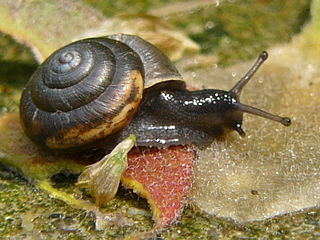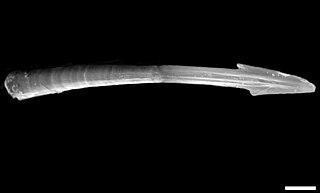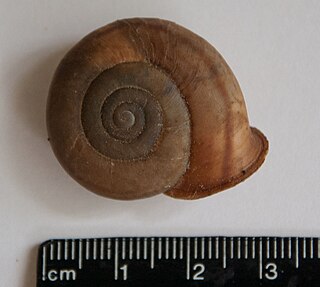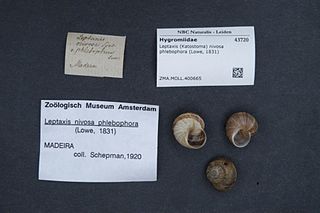
The chlorarachniophytes are a small group of exclusively marine algae widely distributed in tropical and temperate waters. They are typically mixotrophic, ingesting bacteria and smaller protists as well as conducting photosynthesis. Normally they have the form of small amoebae, with branching cytoplasmic extensions that capture prey and connect the cells together, forming a net. They may also form flagellate zoospores, which characteristically have a single subapical flagellum that spirals backwards around the cell body, and walled coccoid cells.

The grove snail, brown-lipped snail or Lemon snail is a species of air-breathing land snail, a terrestrial pulmonate gastropod mollusc.

The operculum, meaning little lid, is a corneous or calcareous anatomical structure like a trapdoor which exists in many groups of sea snails and freshwater snails, and also in a few groups of land snails; the structure is found in some marine and freshwater gastropods, and in a minority of terrestrial gastropods, including the families Helicinidae, Cyclophoridae, Aciculidae, Maizaniidae, Pomatiidae, etc.

The gastropod shell is part of the body of a gastropod or snail, a kind of mollusc. The shell is an exoskeleton, which protects from predators, mechanical damage, and dehydration, but also serves for muscle attachment and calcium storage. Some gastropods appear shell-less (slugs) but may have a remnant within the mantle, or the shell is reduced such that the body cannot be retracted within (semi-slug). Some snails also possess an operculum that seals the opening of the shell, known as the aperture, which provides further protection. The study of mollusc shells is known as conchology. The biological study of gastropods, and other molluscs in general, is malacology. Shell morphology terms vary by species group. An excellent source for terminology of the gastropod shell is "How to Know the Eastern Land Snails" by John B. Burch now freely available at the Hathi Trust Digital Library.

Leptaxis is a genus of air-breathing land snails, terrestrial pulmonate gastropod mollusks in the family Hygromiidae, the typical snails.

Hygromiidae is a taxonomic family of small to medium-sized air-breathing land snails, terrestrial pulmonate gastropod mollusks in the superfamily Helicoidea.

Helicella itala is a species of medium-sized, air-breathing land snail, a terrestrial pulmonate gastropod mollusk in the family Geomitridae, the hairy snails and their allies.

A love dart is a sharp, calcareous or chitinous dart which some hermaphroditic land snails and slugs create. Love darts are both formed and stored internally in a dart sac. These darts are made in sexually mature animals only, and are used as part of the sequence of events during courtship, before actual mating takes place. Darts are quite large compared to the size of the animal: in the case of the semi-slug genus Parmarion, the length of a dart can be up to one fifth that of the semi-slug's foot.
Xerarionta kelletii, common name the Catalina cactus snail, is a species of air-breathing land snail, a terrestrial pulmonate gastropod mollusk in the family Helminthoglyptidae.

Humboldtiana is a genus of American air-breathing land snails, terrestrial pulmonate gastropod mollusks in the subfamily Humboldtianinae.

Chilostoma planospira is a species of medium-sized, air-breathing, land snail, a terrestrial pulmonate gastropod mollusk in the family Helicidae, the true snails.

Leptaxis nivosa is a species of air-breathing land snail, a terrestrial pulmonate gastropod mollusk in the family Helicidae, the typical snails.
Leptaxis undata is a species of air-breathing land snail, a terrestrial pulmonate gastropod mollusk in the family Helicidae, the typical snails.
Marmorana scabriuscula is a species of air-breathing land snail, a terrestrial pulmonate gastropod mollusk in the family Helicidae.

Marmorana serpentina is a species of air-breathing land snail, a terrestrial pulmonate gastropod mollusk in the family Helicidae.

Cernuella cisalpina, sometimes known as the "maritime gardensnail", is a species of small air-breathing land snail, a terrestrial pulmonate gastropod mollusk in the family Geomitridae.

Hygromia cinctella, known commonly as the girdled snail, is a small European species of air-breathing land snail, native to the Mediterranean region, that belongs to the terrestrial pulmonate gastropod mollusk family Hygromiidae.

Xerosecta cespitum is a species of small air-breathing land snail, a terrestrial pulmonate gastropod mollusk in the family Geomitridae, the hairy snails and their allies.
Pterostylis erubescens, commonly known as the red sepaled snail orchid, is a species of orchid endemic to the south-west of Western Australia. Non-flowering plants have a rosette of leaves flat on the ground but flowering plants lack a rosette and have a single large green flower which turns reddish-brown as it ages, and has leaves on the flowering spike.

Leucospermum erubescens is an evergreen shrub of up to 2 m high, with hairless, lancet-shaped to oval leaves with three to seven teeth near the tip of 7–8½ cm long and 1–2 cm wide, slightly asymmetric, oval flower heads of 5–6½ cm in diameter, and usually with four to eight clustered near the end of the branches, with initially yellow flowers, that change to deep crimson, from which long styles stick out, giving the flowerhead as a whole the appearance of a pincushion. It is called orange flame pincushion in English and oranjevlamspeldekussing in Afrikaans. It can be found in South Africa. Flowers may be found between August and January.

















